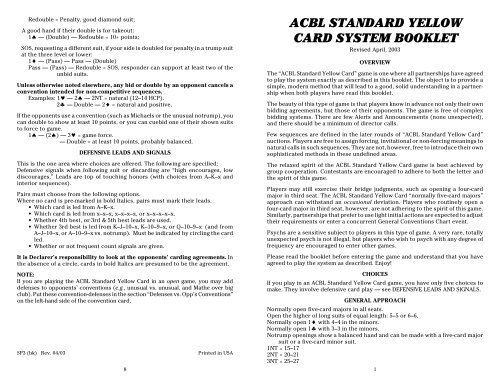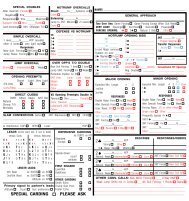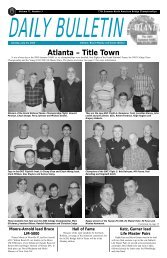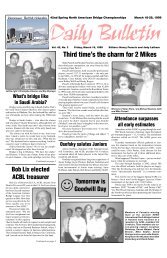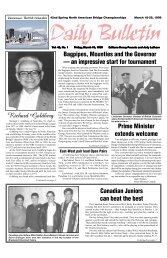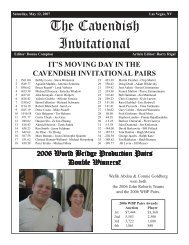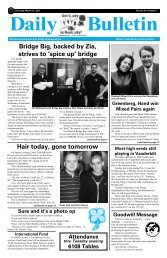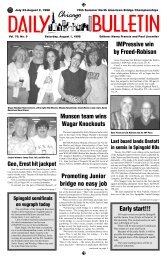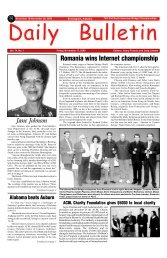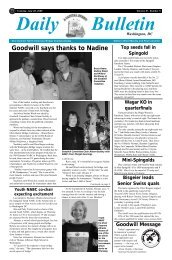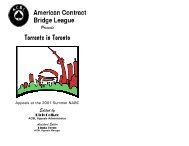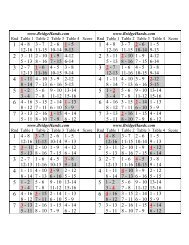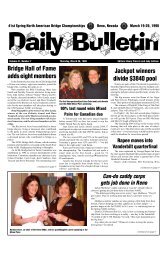ACBL STANDARD YELLOW CARD SYSTEM BOOKLET - Bridge Guys
ACBL STANDARD YELLOW CARD SYSTEM BOOKLET - Bridge Guys
ACBL STANDARD YELLOW CARD SYSTEM BOOKLET - Bridge Guys
Create successful ePaper yourself
Turn your PDF publications into a flip-book with our unique Google optimized e-Paper software.
Redouble = Penalty, good diamond suit;A good hand if their double is for takeout:1♠ — (Double) — Redouble = 10+ points;SOS, requesting a different suit, if your side is doubled for penalty in a trump suitat the three level or lower:1♦ — (Pass) — Pass — (Double)Pass — (Pass) — Redouble = SOS, responder can support at least two of theunbid suits.Unless otherwise noted elsewhere, any bid or double by an opponent cancels aconvention intended for non-competitive sequences.Examples: 1♥ — 2♠ — 2NT = natural (12–14 HCP).2♣ — Double — 2♦ = natural and positive.If the opponents use a convention (such as Michaels or the unusual notrump), youcan double to show at least 10 points, or you can cuebid one of their shown suitsto force to game.1♠ — (2♠) — 3♥ = game force.— Double = at least 10 points, probably balanced.DEFENSIVE LEADS AND SIGNALSThis is the one area where choices are offered. The following are specified:Defensive signals when following suit or discarding are “high encourages, lowdiscourages.” Leads are top of touching honors (with choices from A–K–x andinterior sequences).Pairs must choose from the following options.Where no card is pre-marked in bold Italics, pairs must mark their leads.• Which card is led from A–K–x.• Which card is led from x–x–x, x–x–x–x, or x–x–x–x–x.• Whether 4th best, or 3rd & 5th best leads are used.• Whether 3rd best is led from K–J–10–x, K–10–9–x, or Q–10–9–x (and fromA–J–10–x, or A–10–9–x vs. notrump). Must be indicated by circling the cardled.• Whether or not frequent count signals are given.It is Declarer’s responsibility to look at the opponents’ carding agreements. Inthe absence of a circle, cards in bold Italics are presumed to be the agreement.NOTE:If you are playing the <strong>ACBL</strong> Standard Yellow Card in an open game, you may adddefenses to opponents’ conventions (e.g., unusual vs. unusual, and Mathe over bigclub). Put these convention-defenses in the section “Defenses vs. Opp’s Conventions”on the left-hand side of the convention card.SP3 (bk) Rev. 04/038Printed in USA<strong>ACBL</strong> <strong>STANDARD</strong> <strong>YELLOW</strong><strong>CARD</strong> <strong>SYSTEM</strong> <strong>BOOKLET</strong>Revised April, 2003OVERVIEWThe “<strong>ACBL</strong> Standard Yellow Card” game is one where all partnerships have agreedto play the system exactly as described in this booklet. The object is to provide asimple, modern method that will lead to a good, solid understanding in a partnershipwhen both players have read this booklet.The beauty of this type of game is that players know in advance not only their ownbidding agreements, but those of their opponents. The game is free of complexbidding systems. There are few Alerts and Announcements (none unexpected),and there should be a minimum of director calls.Few sequences are defined in the later rounds of “<strong>ACBL</strong> Standard Yellow Card”auctions. Players are free to assign forcing, invitational or non-forcing meanings tonatural calls in such sequences. They are not, however, free to introduce their ownsophisticated methods in these undefined areas.The relaxed spirit of the <strong>ACBL</strong> Standard Yellow Card game is best achieved bygroup cooperation. Contestants are encouraged to adhere to both the letter andthe spirit of this game.Players may still exercise their bridge judgments, such as opening a four-cardmajor in third seat. The <strong>ACBL</strong> Standard Yellow Card “normally five-card majors”approach can withstand an occasional deviation. Players who routinely open afour-card major in third seat, however, are not adhering to the spirit of this game.Similarly, partnerships that prefer to use light initial actions are expected to adjusttheir requirements or enter a concurrent General Conventions Chart event.Psychs are a sensitive subject to players in this type of game. A very rare, totallyunexpected psych is not illegal, but players who wish to psych with any degree offrequency are encouraged to enter other games.Please read the booklet before entering the game and understand that you haveagreed to play the system as described. Enjoy!CHOICESIf you play in an <strong>ACBL</strong> Standard Yellow Card game, you have only five choices tomake. They involve defensive card play — see DEFENSIVE LEADS AND SIGNALS.GENERAL APPROACHNormally open five-card majors in all seats.Open the higher of long suits of equal length: 5–5 or 6–6.Normally open 1♦ with 4–4 in the minors.Normally open 1♣ with 3–3 in the minors.Notrump openings show a balanced hand and can be made with a five-card majorsuit or a five-card minor suit.1NT = 15–172NT = 20–213NT = 25–271
Strong conventional 2♣ opening.Weak two-bids in diamonds, hearts and spades.RESPONSES AND LATER BIDDING AFTER A 15–17 1NT OPENING2♣ is “non-forcing” Stayman, meaning that the bidding can stop in two of a suit.Opener rebids 2♥ with 4–4 in the majors. If responder rebids three of either minor,he shows slam interest and at least a five-card suit.The Jacoby transfer that shows a five-card suit is used for the majors: 2♦ is atransfer to hearts, 2♥ is a transfer to spades. Opener accepts the transfer, thoughhe can jump to the three level with 17 points and four-card support for responder’smajor. For example:1NT — 2♦2♥ = normal acceptance of the transfer.3♥ = 17 points and four-card heart support.If, after the transfer is accepted, responder bids a new suit, that is natural andgame forcing. Possible calls after the accepted transfer are:1NT — 2♥2♠ — Pass = content to play 2♠.— 2NT, 3♠ = invitational. Over 2NT opener may pass or bid 3♠with a minimum hand; bid 3NT or 4♠ with a maximum.— 3♣, 3♦, 3♥ = natural and game forcing.— 3NT = asking for a choice between 3NT and 4♠.— 4♠ = placing the contract, with a six-card or longer suit.A 2♠ response requires the 1NT bidder to rebid 3♣, which may be passed with aclub bust, or responder may rebid 3♦ with a diamond bust. Example:1NT — 2♠3♣ — Pass = club bust— 3♦ = diamond bust (notrump opener passes).Other responses to 1NT:1NT — 3♣, 3♦ = a six-card or longer suit and invitational to 3NT.— 3♥, 3♠ = at least a six-card suit and slam interest (otherwise,responder uses a transfer bid).— 4♣ = Gerber, asking for aces. 4♣ IS GERBER OVER ANY 1NT OR 2NTBY PARTNER, INCLUDING A REBID OF 1NT OR 2NT. Responsesshow the number of aces, by steps, just as over a Blackwood4NT. 5♣ is used to ask for kings.Ace AskingKing Asking1NT — 4♣ 1NT — 4♣4♦ = 0 or 4 aces 4x = 5♣4♥ = 1 ace 5♦ = 0 or 4 kings4♠ = 2 aces 5♥ = 1 king4NT = 3 aces 5♠ = 2 kings5NT = 3 kingsIf the player using Gerber makes any bid other than 5♣, that is to play(including 4NT).A direct raise of 1NT to 4NT is natural and invites 6NT. 4NT is slam invitational onlybecause 4♣ is available as Gerber (to ask about aces).2Responder can bid 2NT over a major suit cuebid to ask for partner’s minor.(1♥) — 2♥ — (Pass) — 2NT (asks for the minor).(Pass) — 3♣ = club suit.—3♦ = diamond suit.A reopening bid means much the same as a direct seat bid, though it can be lighterat the minimum end. A reopening 1NT after an opponent has opened shows 10–15points. This is a wide range, but there will not usually be a game on for you.A double is for takeout over an opening partscore bid (4♦ or lower); penalty overopening game bids (4♥ or higher). A below-game jump response to a takeoutdouble is invitational. To force, responder cuebids opener’s suit.Versus an opening preempt, an overcall in a suit or notrump is natural; a cuebid isMichaels.COMPETITIVE BIDDINGThere is almost an endless variety of possible sequences, so it pays to have simpleguidelines to prevent bidding misunderstandings.Bids mean the same things they meant without the intervening bid. Still, it issometimes necessary to pick a bid that would normally have been a second choicewithout the overcall:1♦ — (Pass) — 1♠ — (2♣)2♠ with ♠J 4 3 ♥A 8 7 5 ♦A Q J 4 ♣J 3 (rebid 1NT if RHO has passed)Cuebidding right-hand opponent’s suit shows values for game without cleardirection for the moment. This is often used to show a game-forcing raise:1♠ — (2♣) — 3♣ = game force; usually a raise.The negative double is used through 2♠ promising four cards (at least) in an unbidmajor. Bidding a major at the two level or higher shows 11 or more points and afive-card or longer suit.1♣ — (1♦) — Double = 4–4 or better in the majors.1♦ — (1♥) — Double = exactly four spades (1♠ promises five).1♦ — (1♠) — Double = four hearts and 6+ points or five hearts and 5–10 points.If RHO makes a takeout double:1♦ — (Double) — 1♥, 1♠ = forcing, point count not limited.— 2♣ = non-forcing (6–10 points, usually a six-card suit).— 2NT = limit raise (at least 10 points) — or better.— Redouble = 10 points or more, but it is better to make a moredescriptive bid of 1♥, 1♠, or 2NT with the appropriate hand.— 3♦ = preemptive, good trump support but fewer than 10 points.A responder’s jump shift after a double is to play:1♦ — (Double) — 2♥, 2♠, 3♣ = six-plus card suit, like a weak two-bid orpreemptive three-bid.A redouble can have one of three meanings:To play if:Your side is at the four level or higher:4♠ — (Double) — Redouble = Penalty;The opponents double a conventional bid:1NT — (Pass) — 2♦ — (Double)7
“RONF” on the card means “Raise Only Non-Force.” A new-suit response is forcingone round and shows at least a five-card suit. Opener should raise a major suitresponse with a three-card fit, or perhaps with a doubleton honor.With no fit for responder’s suit, opener rebids:With a minimum weak two-bid (5–8 points), rebid the suit at the lowest level.With a maximum weak two-bid, name a new suit or bid notrump.SLAM BIDDINGBlackwood 4NT is used to ask for aces. Responses show the number of aces bysteps. 5NT is then used to ask for kings; 5NT guarantees the partnership holds allfour aces.— — — — — —— — 4NT — — 4NT5x — 5NT5♣ = 0 or 4 aces 6♣ — 0 or 4 kings5♦ = 1 ace 6♦ — 1 king5♥ = 2 aces 6♥ — 2 kings5♠ = 3 aces 6♠ — 3 kingsA jump to 5NT (and some 5NT bids when the auction is at the five level) is “GrandSlam Force,” asking partner to bid a grand slam with two of the three top trumphonors;5NT — 6 of the trump suit = fewer than two top trump honors (A, K, or Q).— 7 of the trump suit = two of the three top trump honors.DEFENSIVE BIDDINGOvercalls show 8–16 points (double and bid the long suit with a stronger hand).The only forcing response is a cuebid of opener’s suit, asking the overcaller aboutthe quality of his overcall:(1♦) — 1♠ — (Pass) — 2♦(Pass) — 2♠ = minimum overcall.— other = extra strength (11 or 12 points minimum).A 1NT overcall shows 15–18 points and a balanced hand (preferably a stopper inopener’s suit). No conventional responses are used to the 1NT overcall except 2♣,which is Stayman.A jump overcall of 2NT shows at least 5–5 in the lower two unbid suits.Jump overcalls are preemptive, showing the same value as an opening bid at thesame level:(1♦) — 2♠ = a hand that would open a weak two-bid in spades.— 3♣ = a hand that would open 3♣.A cuebid overcall when the opponents have bid two suits is natural in either suit.A cuebid overcall when the opponents have bid only one suit is a Michaels cuebid,showing a 5–5 two-suiter (or more distributional). If the opening is in a minor suit,the cuebid shows the majors; if the opening is in a major, the cuebid shows theother major and an unspecified minor.(1♦) — 2♦ = at least 5–5 in the majors, 8 points or more.(1♠) — 2♠ = at least 5–5 in hearts and a minor; 10 points or more.INTERFERENCE AFTER A 1NT OPENING BIDIf an opponent doubles, all conventional responses are “on.” For example:1NT — (Double) — 2♣ = Stayman1NT — (Double) — 2♦ = transfer to heartsIf an opponent bids over your 1NT opener, conventional responses like Staymanand transfers are “off.” Bids are natural except for a cuebid, which can be used withgame forcing strength as a substitute for Stayman.If the opponents intervene over a conventional response, bids carry the samemeaning as if there were no intervention. A bid says, “I’m bidding voluntarily, soI have a real fit with you.”1NT — (Pass) — 2♦ — (Double)2♥ = Real fit for hearts — pass with only two heartsRESPONSES TO A 2NT OR A 3NT OPENINGStayman and Jacoby transfers for the majors are used.2NT — 3♣ = Stayman.—3♦, 3♥ = Jacoby transfers to hearts and spades, respectively.—4♣ = Gerber (ace asking).— 4NT = Invites a slam in notrump.3NT — 4♣ = Stayman.—4♦, 4♥ = Jacoby transfers to hearts and spades, respectively.RESPONSES AND LATER BIDDING AFTER A 1♥ OR A 1♠ OPENING1♥ and 1♠ openings show a five-card or longer suit. Responses:1 ♥ — 1♠ = at least four spades, 6 or more points. Tends to deny a heart fit.— 1NT = 6–10 points, denies four spades or three hearts. NOT forcing.— 2♣, 2♦ = 11 points or more, promises at least four of the suit.— 2♥ = three-card or longer heart support; 6–10 dummy points.— 2NT = Game-forcing raise (Jacoby 2NT), 13+ dummy points. Asksopener to show a short suit to help responder evaluate slam prospects.— 2♠, 3♣, 3♦ = strong jump shifts. Invites a slam.— 3♥ = limit raise (10–12 dummy points with three or more hearts).— 3NT = 15–17 HCP, balanced hand with two-card support for partner.— 4♥ = usually five+ hearts, a singleton or void, and fewer than 10 HCP.Opener’s rebids are natural and standard.Rebids with a minimum hand (13–16 points):Rebidding notrump at the lowest available level;Raising responder’s suit at the lowest level (may have good three-card support);Rebidding a new suit at the one level or rebidding a new suit at the two level thatis lower ranking than the opening suit (not reversing);Rebidding opener’s suit at the lowest level.Rebids with a medium hand (17–18 points):Jump raise or jump rebid of opener’s suit;Reverse in a new suit, i.e., bid a new suit at the two level which is higher rankingthan the opening suit;Non-reverse bid in a new suit (this has the wide range of 13–18 points).63
With a maximum hand (19–21 or 22 points) opener must make a very strong rebid:Jump in notrump;Double jump raise of responder’s suit or double jump rebid of opener’s suit;Jump shift in a new suit.If responder jumps to 2NT over a 1♥ or 1♠ opening, that is Jacoby2NT, asking opener to show a singleton or void. If opener has no shortsuit, he shows his hand strength;1♥ — 2NT3♣, 3♦, 3♠ = singleton or void in that suit. Other bids deny a short suit.4♥ = minimum hand.3NT = medium hand (15–17).3♥ = maximum hand (18+)Responder follows up by attempting to sign off in game, bidding 4NTBlackwood, or cuebidding if still interested in trying to cooperate with openerin making the slam decision.SUBSEQUENT BIDDING BY RESPONDERIf responder has bid a suit at the one level, he next determines whether he wishesto sign off in a partscore, invite game, sign off in game, or force to game and getmore information about opener’s hand.Bids available for a sign-off in partscore: Pass, 1NT, 2 of a previously bid suit.1♥ — 1♠2♣ — Pass, 2♥, 2♠ = 6–10 points, sign-off in partscore.Bids available for inviting game: 2NT, 3 of a previously bid suit:1♥ — 1♠2♦ — 2NT, 3♦, 3♥, 3♠ = 11–12 points, inviting game.After opener rebids in a suit, a new suit by responder is forcing. If the new suit is thefourth suit, the bid may be artificial/conventional.1♥ — 1♠2♣ — 2♦ = one-round force, could be conventional.However, after a 1NT rebid by opener, bids of a new suit at the next higher level arenon-forcing.1♥ — 1♠1NT — 2♣, 2♦ = non-forcing. Responder must jump shift to 3♣ or 3♦ to force game.Second-round forcing bids following a 1NT rebid by opener: a reverse or jump shiftinto a new suit is a game force.1♣ — 1♥1NT — 2♠ or 3♦ = game force.Bids available for signing off in game.3NT, 4♥, 4♠, 5♣, 5♦.If responder initially bids a new suit at the two level, the same rules apply EXCEPTthat a subsequent jump raise of opener’s first suit to the THREE LEVEL is gameforcing — responder should make a limit raise directly over the opening with 10–12points and at least three-card support:1♠ — 2♣2♥ — 2NT, 3♣, 3♥ = Invitation to game (11–12 points).— 2♠ = preference, not forcing. Responder has 11–12 points and adoubleton spade.— 3♦ = game force, could be conventional.— 3♠ = game force.4NOTE: Responder promises to bid again if he responded with a new suit at the twolevel unless opener’s rebid is at the game level.1♠ — 2♣2♦ = forcing one round. Responder can limit his hand by bidding 2♠, 2NT, 3♣,or 3♦ at this point. He should not pass, since opener could have 18points (just short of a jump shift rebid).RESPONSES TO A 1♣ OR A 1♦ OPENINGA 1♦ opener suggests a four-card or longer suit, since 1♣ is preferred on handswhere a three-card minor suit must be opened. The exception is a hand with 4–4–3–2 shape: four spades, four hearts, three diamonds, and two clubs, which shouldbe opened 1♦.Responses and later bidding generally follow the ideas set down in the previoussection. Bidding at the one level is up-the-line in principle. Responder needs moretrumps to raise (four to raise 1♦; five to raise 1♣, though one fewer trump will doin a pinch in a competitive sequence). Responses of 2NT and 3NT are standard:1♣ — 2NT = 13–15, game forcing— 3NT = 16–17There is no forcing minor-suit raise.A 2♣ OPENING, RESPONSES, AND LATER BIDDINGA 2♣ opening shows at least 22+ points, or the playing equivalent. Responses:2♣ — 2♦ = conventional, could be “waiting” with a good hand not suited to apositive response.— 2♥, 2♠, 3♣, 3♦ = natural and game forcing. At least a five-card suit and8 points.— 2NT = a balanced 8 HCP.If opener rebids 2NT after a 2♦ response (showing 22–24 points), the sameresponses are used as over a 2NT opening:2♣ —2♦2NT — 3♣ = Stayman.—3♦, 3♥ = Jacoby transfers to hearts and spades, respectively.—4♣ = Gerber.— 4NT = inviting a slam in notrump.If opener rebids a suit over a 2♦ response, the bidding is forcing to 3 of opener’smajor or 4 of opener’s minor.2♣ — 2♦2♥ — 2♠3♥ = not forcing.SEQUENCE AFTER A WEAK TWO-BID OF 2♦, 2♥, OR 2♠A weak two-bid shows a six-card suit of reasonable quality and 5–11 HCP. On rareoccasions it may be a very good five-card suit. It is possible to open a weak two witha poor seven-card suit (not good enough to open with at the three level). Responses:A 2NT response is forcing, showing game interest. (This applies also if theopponents intervene with a double or a bid.) Opener rebids his suit with aminimum weak two (5–8 points). With a maximum hand opener bids anothersuit to show a “feature” (ace or king in that suit); lacking a feature, he raises to3NT and lets responder place the contract.Any raise of opener’s suit is to play and could be preemptive. A 3NT responseis also to play.5


